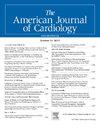接受外科主动脉瓣置换术的医疗保险受益人主动脉根部扩大的外科医生频率和长期生存率。
IF 2.3
3区 医学
Q2 CARDIAC & CARDIOVASCULAR SYSTEMS
引用次数: 0
摘要
主动脉根部扩大术(ARE)是外科主动脉瓣置换术(SAVR)中用于减少患者-假体不匹配(PPM)的可变方法,但其对生存的影响仍未得到充分评估。我们回顾性分析了1999-2019年接受孤立性SAVR伴或不伴非konno ARE的医疗保险受益人。程序细节由ICD和CPT代码双重裁定。重叠倾向评分加权调整混杂因素。比较30天和20年的限制平均生存时间(RMST)。根据ARE频率对外科医生进行分层,并使用风险调整的Kaplan-Meier估计在“接受治疗”(SAVR vs SAVR+ARE)和“外科医生偏好”(从未接受过ARE vs经常接受ARE的外科医生)分析中分析生存率。在接受孤立SAVR的214,266名受益人中,6,652名(3.1%)接受了SAVR+ARE。从1999年到2019年,ARE利用率从2.1%上升到6.4% (Cochran-Armitage z统计量:15.2)。在3018名外科医生中,1513名从未做过器官移植(69389名受益者),1227名在美国做过器官移植本文章由计算机程序翻译,如有差异,请以英文原文为准。
Surgeon Frequency of Aortic Root Enlargement and Long-Term Survival in Medicare Beneficiaries Undergoing Surgical Aortic Valve Replacement
Aortic root enlargement (ARE) is a variably performed during surgical aortic valve replacement (SAVR) to minimize patient-prothesis mismatch (PPM), but its impact on survival remains under-evaluated. We retrospectively analyzed Medicare beneficiaries (1999–2019) undergoing isolated SAVR with or without non-Konno ARE. Procedural details were doubly-adjudicated by ICD and CPT codes. Overlap propensity score weighting adjusted for confounders. Restricted mean survival times (RMST) at 30-days and 20-years were compared. Surgeons were stratified by ARE frequency, and survival was analyzed using risk-adjusted Kaplan-Meier estimates in both “as-treated” (SAVR vs SAVR+ARE) and “surgeon-preference” (never-ARE vs frequent-ARE surgeons) analyses. Of 214,266 beneficiaries undergoing isolated SAVR, 6,652 (3.1%) underwent SAVR+ARE. From 1999 to 2019, ARE utilization increased from 2.1% to 6.4% (Cochran-Armitage Z-statistic: 15.2). Among 3,018 surgeons, 1,513 never performed ARE (69,389 beneficiaries), 1,227 performed ARE in <10% of cases (128,258 beneficiaries), and 278 performed ARE in ≥10% of cases (16,619 beneficiaries). After risk-adjustment, survival was significantly lower in SAVR+ARE compared to SAVR recipients: 30-day RMST 28.73 (28.60,28.87) versus 29.35 (29.26,29.45) days (p = 0.013) and 20-year RMST 9.15 (8.96,9.35) vs 9.49 (9.30,9.69) years (p = 0.018). Similarly, beneficiaries treated by frequent-ARE surgeons experienced worse early risk-adjusted survival without any late survival benefit: 30-day RMST 29.19 (29.11,29.27) versus 29.33 (29.25-29.40) days (p = 0.013), 20-year RMST 9.04 (8.90,9.18) versus 9.13 (9.00,9.27) (p = 0.351). Landmark analysis of 1-year survivors showed no late survival difference (p = 0.456 “as-treated” analysis; p = 0.943 “surgeon-preference” analysis). Even among frequent-ARE surgeons, SAVR+ARE was associated with higher 30-day and reduced 20-year RMST relative to SAVR alone. In conclusion, ARE was associated with higher early mortality and no long-term survival advantage compared to SAVR alone (even among frequent-ARE surgeons), as was undergoing surgery by a frequent ARE surgeon. Further studies are required to assess the potential utility of ARE in younger patients, those with small annuli, and those at risk for PPM.
求助全文
通过发布文献求助,成功后即可免费获取论文全文。
去求助
来源期刊

American Journal of Cardiology
医学-心血管系统
CiteScore
4.00
自引率
3.60%
发文量
698
审稿时长
33 days
期刊介绍:
Published 24 times a year, The American Journal of Cardiology® is an independent journal designed for cardiovascular disease specialists and internists with a subspecialty in cardiology throughout the world. AJC is an independent, scientific, peer-reviewed journal of original articles that focus on the practical, clinical approach to the diagnosis and treatment of cardiovascular disease. AJC has one of the fastest acceptance to publication times in Cardiology. Features report on systemic hypertension, methodology, drugs, pacing, arrhythmia, preventive cardiology, congestive heart failure, valvular heart disease, congenital heart disease, and cardiomyopathy. Also included are editorials, readers'' comments, and symposia.
 求助内容:
求助内容: 应助结果提醒方式:
应助结果提醒方式:


